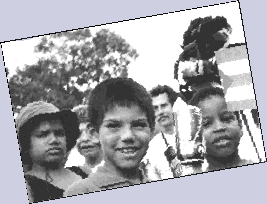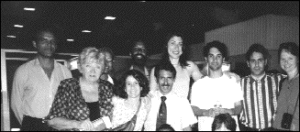A delegation of nine journalists organized by Media Alliance and Global Exchange visited Cuba for eight days in April and May. The U. S. government places severe restrictions on Americans who want to travel to Cuba–journalists are among the few who can freely travel there–but the Cubans (and their government) welcome visitors from their powerful northern neighbor. The delegation, hosted in Cuba by Radio Havana, met with Cuban and international journalists, representatives of women’s and community organizations, economists, health practitioners, and others–including some really good salsa dancers. In this article, one of the gals on the bus, ACLU News editor Elaine Elinson( front right), shares a few of her impressions.
Magnolia trees and purple jacarandas sweeten the heavy tropical air of the courtyard of the UPEC building, whose marble staircase and stately columns testify to its past as an old Havana mansion. Its former occupants self-exiled to Miami, the building now serves as national headquarters of the Cuban Journalists Union, and greeting us as we entered the mahogany-lined anteroom was a larger-than-life poster of Che–the same one (black beret, steady gaze) plastered on dorm room walls across my college campus almost 30 years ago. A guerrilla leader in the newsroom–there could be no clearer sign that, while we were only 90 miles off the coast of Florida, we were very far from home.
We sat in overstuffed maroon leather chairs in the formal meeting room and listened to veteran reporter and UPEC Vice President Juan Marrero talk about the confused, heady days of journalism in 1959 Cuba. Although some Batista-controlled papers closed down and their owners fled the country when Castro declared victory in January of that year, other publishers stayed on, documenting the early days of the revolution with cautious praise. But four months later, when Castro announced Agrarian Reform, which divided up the property of large landowners and distributed it to the formerly landless tenant farmers, the publishers changed their tone, launching a vicious attack on the audacious new government.
“What were we journalists to do?” Marrero asked, looking at us through owlish glasses, challenging us to solve this vexing political question. The needles of our tape recorders twitched, monitoring our silence. “We were also exploited workers–we wanted to keep on writing, but we didn’t want to support the promulgation of the publishers’ lies. That is when we discovered the power of the coletilla–the footnote.
“You see, after the papers had gone to bed, at the end of the articles and editorials maligning the revolution, we would add this phrase: ‘We, the journalists and typographers, oppose what is written in this article.’
“The publishers didn’t see it until the next morning, and what could they do? Eventually they all left for Miami, and the journalists took over the paper,” Marrero said.
Our group’s host, Radio Havana, was similarly born of protest and practicality. On April 15, 1961, U. S. planes painted with Cuban flags bombed Santiago de Cuba. At the funeral and rally for the victims, Castro announced that Cuba would launch its own shortwave radio station to combat the counter-revolutionary misinformation campaign sponsored by the CIA. Radio Havana now employs 90 journalists and broadcasts around the world in nine languages.
Cuba has always been a poor country, and the current U. S. blockade–recently tightened by the Helms-Burton Law–is aimed at keeping it that way. But even the Cubans were unprepared for the precipitous nose-dive their economy took with the dissolution of the Soviet Union and Comecon (the former socialist trade organization) in 1991. The country lost 85 percent of its trade, its market for sugar, and its source of hard currency and petroleum.
We observed many of the ingenious means Cubans have devised for coping with what they call the “special period.”
With no gasoline or spare parts for cars and buses, people get to work on “camels”–city buses whose bodies are still intact but whose Czech engines no longer work. The buses, painted green, pink, or blue to identify their routes, are pulled along the streets of the capital by tow trucks. Cubans also commute on a million bicycles imported from China–although the 54-pound “flying pigeons” are slow-going in the sweltering heat and rutted streets of Havana.
When the cut-off of fertilizer, seeds, and pesticides previously supplied by Eastern Bloc countries led to severe food shortages, a new Department of Urban Organic Farming was formed in the Ministry of Agriculture to pick up the slack. Cubans now grow vegetables on every conceivable patch of city land.
Agronomist Egelio Paz Medina took us to garden plots in the courtyards of crumbling, Soviet-style apartment blocks in El Alamar on the outskirts of Havana. “We grow chaya,” he said, holding up a clutch of spinach-like dark green leaves, “which is rich in iron–and lettuce, radishes, cilantro, and cabbage. And, of course, sunflowers.” Standing in the rows of herbs and marigolds, I thought of the Taoist proverb, “If I only had enough money for a loaf of bread, I would buy half a loaf and with the rest, buy chrysanthemums.” It seems so apt here. Of course, on this sunny island, sunflowers.
The photo of JoJo White hit me like a bullet. The last time I had seen this picture of the thin, bearded, 23-year-old was on a handmade poster at a vigil outside the gates of San Quentin the night William Bonin was executed. At the top of the poster, above the photo, was written in black marker, “Who Killed JoJo White?” Below the photo it read, “My son was killed by a society that leads other young men to rob and kill. I oppose the death penalty.”
I remembered that I was shy that night about approaching the man holding the sign–JoJo’s father. But I did it, because his son looked just like one of my son’s friends, skinny and smiling, with his dark dreadlocks curling out from under a knit cap. And his son’s death, at the foot of Potrero Hill driving some friends home from a rec center, could have happened to my son or his bearded friend.
But why was the photo of JoJo White displayed on a bulletin board in a community center in La Guinera, a working-class suburb of Havana? This site was on our schedule because brigades of neighborhood women had built their own homes here to replace plywood-and-aluminum shacks and festering, ancient apartment buildings. The government provided the building supplies, but the women did everything else themselves. Fifi, who told us she was a domestic worker before the revolution, headed up the women’s teams.
“We tried to get our husbands to help,” she explained as we sat in the whitewashed community center, “but they weren’t interested. They didn’t want to do the extra work, so we built the houses ourselves.
“And you know what?” She grinned triumphantly and pointed her finger in the air. “We built new men, too, because when they saw what we could do, and the work they had to do because we were out building–the cooking, cleaning, and looking after all the children–they changed.”
The community center was their latest project. “This is so the children have a place to come to dance, watch movies, play sports,” Fifi said.
We went around the room, bathed in sunlight from the big louvered windows, and introduced ourselves. When it was my turn, I had to ask, “Why is this center named after JoJo White?”
Fifi explained that JoJo had come here with a volunteer youth brigade to help build the houses several years ago. When he was murdered in San Francisco, his family and friends raised money to build something for La Guinera. His parents also traveled to Cuba with 35 young men and women–friends of JoJo’s–to visit the community. “We decided to name this center after him,” Fifi said.
She and a delegation of women builders had to present the proposal to the municipal, regional, and provincial government councils for approval. “In Cuba, you don’t just go around naming things after anyone–especially North Americans.”
In the States, I thought, hardly anyone knows his name. Here, in remote La Guinera, everyone does.
*
On one of our last nights in Cuba, in the seaside provincial capital of Matanzas, after a day of interviews at the Protestant Seminary, the Clinica de Medicina Tradicional y Natural, and neighborhood revolutionary defense committee number 21, we decide to go dancing.
After driving for half an hour through unlit streets, we finally find the dance hall–a squat concrete building sitting at the far end of an empty parking lot, marked by an obscure hand-lettered sign “Artex–Discoteca y Karaoke.”
In we go, a bedraggled crew of U. S. journalists in t-shirts, sandals, and jeans to join the revelers of Matanzas–young women in high heels, tight black sheaths, and fancy hairdos, their partners in sharp black suits with white satin ties.
It’s smoky from unfiltered cigarettes and Cohiba cigars. There are two choices of drinks–beer or Cuba Libres (rum and Coke). Really three, one of the group says–plain Coke. Make that four, says Francisco, our affable, poetry-quoting guide–plain rum. He orders a round.
We salsa, jitterbug, twist, and line dance, spanning generations, geography, and ability. The only karaoke video they play is probably the only song in the world you don’t need karaoke for–“La Bamba.” We all stand there watching the screen and the little bouncing ball coloring the words, “Bamba, bamba, bamba, bamba.”
Then a slow song starts, with swelling orchestral strains. The Cuban couples get up and dance in sweeping, graceful circles. Our group is sitting it out until Ahmed, our bus driver, always sharply turned out in a blue dress shirt and tie, asks me to dance, and we join the elegant pairs on the concrete dance floor. “This is the most beautiful song,” he says.
I can’t quite place it; the words are in Spanish. “What is it?” I ask him.
“The theme from Titanic.”
So, we’re dancing in the middle of the night in a smoky bar in Matanzas, a place where the U. S. government forbids most of its citizens to go, to the theme from Titanic. Gabriel García Marquez doesn’t have to make up magical realism. He’s just writing what he sees.
Photo © 1998 Elaine Elinson May Day demonstrators.
Source: Media File, Volume 17 #4, Sep-Oct 1998


